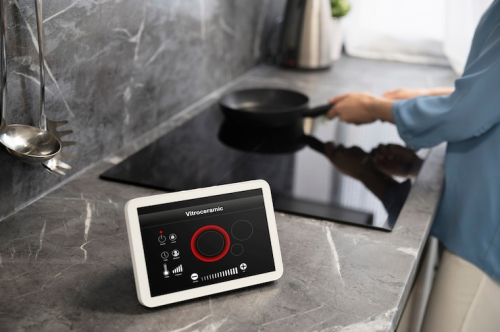Quick Listen:
In the high-stakes world of a restaurant kitchen, where every second shapes the customer experience, precision and speed reign supreme. Orders pour in from servers, online platforms, and drive-thru lanes, each demanding flawless execution. A single error a misplaced ticket or a misread order can disrupt the flow, frustrate diners, and strain operations. For years, kitchens relied on handwritten paper tickets, a system as error-prone as it was outdated. Now, a transformative technology is reshaping the back of house: Kitchen Display Systems (KDS), digital command centers that streamline workflows, reduce mistakes, and propel restaurants into the future.
The Digital Backbone of Modern Kitchens
A Kitchen Display System is more than a screen it’s a sophisticated software solution that replaces chaotic paper tickets with real-time, digital order management. Integrated seamlessly with point-of-sale (POS) systems, a KDS funnels orders from multiple sources servers, mobile apps, or delivery platforms directly to the kitchen. The result? No more lost tickets or misinterpreted handwriting. The SUNMI D2s KDS, for instance, features a 15.6-inch HD display that presents orders with crystal clarity, minimizing errors and keeping kitchen and front-of-house teams in perfect sync. Its Android OS ensures compatibility with various POS systems, making it a versatile choice for high-traffic environments.
The impact of KDS extends beyond digitization. These systems orchestrate the frenetic pace of a busy kitchen, turning disorder into efficiency. Tools like Epson’s KDS empower managers to monitor ticket times, identify bottlenecks, and streamline back-of-house operations. Features such as bump bars tactile keypads that allow cooks to mark orders as complete add a layer of practicality, enabling kitchens to maintain rhythm during peak hours. For restaurants, this translates to faster service, happier customers, and improved profitability.
The market reflects this shift. Valued at $101.5 billion in 2023, the global KDS market is projected to reach $260.4 billion by 2032, growing at a compound annual growth rate (CAGR) of 12.50%, according to Market Research Future. This growth is fueled by a surge in demand for technological advancements that enhance operational efficiency across the restaurant industry.
Why Restaurants Are Embracing KDS
The adoption of KDS is driven by a clear need for speed and accuracy. A 2024 report from Astute Analytica reveals that 91% of restaurants are exploring kitchen automation to meet rising customer expectations. North America leads the global KDS market, propelled by its vast restaurant industry and a culture of technological innovation. The rise of ghost kitchens delivery-only operations that depend on precise order management has further accelerated KDS adoption, as these setups rely on systems like KDS to handle high-volume, app-driven orders efficiently.
KDS delivers measurable results. Consider a fast-casual chain in the Midwest that integrated a KDS with its mobile ordering platform. By displaying orders in real time and prioritizing them by urgency, the chain significantly reduced average ticket times, boosting table turnover and customer satisfaction. Drive-thru operators have reported similar gains, using dual-screen KDS setups to coordinate front- and back-of-house teams, ensuring orders reach customers swiftly.
Integration with delivery platforms like Uber Eats or DoorDash is another game-changer. Orders flow directly into the KDS, eliminating manual entry and reducing errors. This allows cooks to focus on food preparation rather than administrative tasks, enhancing both speed and quality. Operations managers praise KDS for its clarity, with one noting that it significantly improves kitchen efficiency by providing real-time insights into workflow bottlenecks.
Trends Shaping the Future of KDS
The KDS of 2025 is a far cry from the clunky monitors of the past. Cloud-based systems have made KDS more agile, enabling seamless integration with POS platforms, mobile apps, and even Internet of Things (IoT)-enabled appliances. Picture a fryer that signals the KDS when it’s ready for the next batch or a grill station that adjusts its queue based on real-time order spikes. These innovations are becoming reality, driven by a market that demands flexibility and precision.
Compact, touchscreen-based systems are replacing bulky hardware, offering customizable interfaces that adapt to a kitchen’s unique workflow. The JIB NGenDXII Controller, priced at $769 with a $299 bump bar, is a prime example. Its small footprint suits cramped kitchens, yet its robust processing power handles complex configurations with ease. Such systems cater to operators balancing cost and performance, making KDS accessible to a wide range of establishments.
Artificial intelligence (AI) is also making inroads. AI-driven forecasting can predict peak hours, enabling kitchens to prep smarter and reduce waste. Voice-assisted alerts imagine a calm, automated voice announcing “Order 45, expedite!” complement visual displays, ensuring no ticket is overlooked during a rush. These advancements address the industry’s need for tools that enhance both speed and reliability.
Challenges of Going Digital
Despite its benefits, implementing a KDS is not without hurdles. Compatibility issues with legacy POS systems can disrupt service, particularly for older establishments. Small, independent restaurants often hesitate due to upfront costs, as systems like Epson’s KDS require monitors and configuration, which can strain tight budgets. The human element poses another challenge veteran cooks accustomed to paper tickets may resist learning a new system, and touchscreens can feel impractical in greasy, high-pressure environments.
Training is essential to ensure smooth adoption, as is reliable technical support. A KDS failure during a dinner rush can cripple operations, and the wealth of data ticket times, order stats can overwhelm managers without proper guidance. Yet, with careful planning and robust support, these obstacles can be overcome, paving the way for a more efficient kitchen.
The Payoff: A Smarter, Faster Kitchen
The benefits of KDS are undeniable. Faster ticket times increase table turnover, allowing restaurants to serve more customers. Fewer errors mean fewer comped meals and happier diners. Enhanced reporting empowers managers to analyze performance metrics, from prep times to peak-hour efficiency, and make data-driven improvements. Communication between front- and back-of-house teams also improves, eliminating confusion over order statuses.
The global KDS market’s projected growth from $450 million in 2023 to $801.2 million by 2032, at a CAGR of 6.62%, according to Astute Analytica underscores its transformative potential. For multi-unit operators, centralized dashboards provide a comprehensive view of performance across locations, enabling strategic decision-making.
The Road Ahead: A Connected Kitchen
The future of KDS lies in deeper integration with AI and predictive analytics. Imagine a system that not only displays orders but anticipates them, adjusting prep schedules based on historical data or external factors like weather patterns. Personalized dashboards could allow cooks to track their performance, turning repetitive tasks into engaging challenges. As labor shortages persist and customer expectations rise, KDS will evolve from a luxury to a necessity.
For restaurant operators, the time to act is now. Whether it’s a compact JIB controller for a food truck or a multi-station Epson setup for a full-service restaurant, piloting a KDS tailored to your workflow is a step toward future-proofing your business. The next time a perfectly timed dish arrives at your table, consider the unsung hero behind it: a KDS, quietly transforming chaos into culinary precision.
Market Insight: The global Kitchen Display System market is set to grow from $114.1 billion in 2024 to $260.4 billion by 2032, driven by demand for technological advancements that enhance efficiency and accuracy in restaurant operations, according to Market Research Future.
Disclaimer: The above helpful resources content contains personal opinions and experiences. The information provided is for general knowledge and does not constitute professional advice.
You may also be interested in: 7 Best Restaurant POS Systems 2024
Scattered systems and manual processes erode your restaurant’s margins daily. Milagro unifies POS, digital menus, online ordering, staffing, loyalty, and AI-powered marketing into one platform, slashing costs and enhancing guest loyalty. Reclaim control over operations and drive revenue growth. Streamline your workflow and elevate profitability. Schedule your Milagro demo today!
Powered by flareAI.






